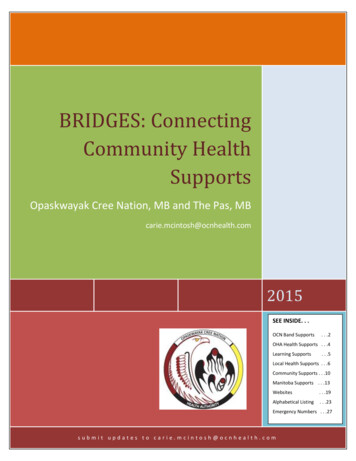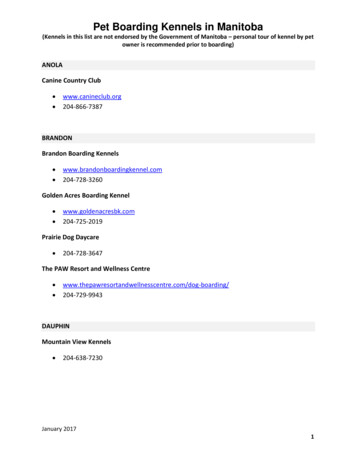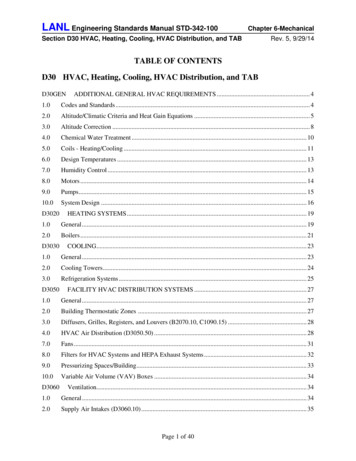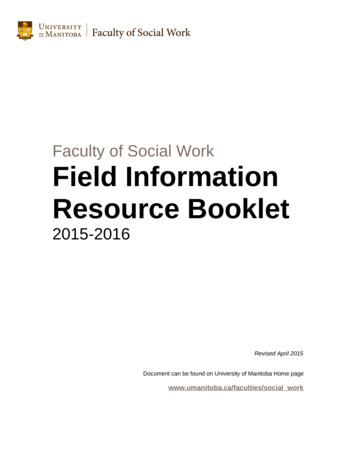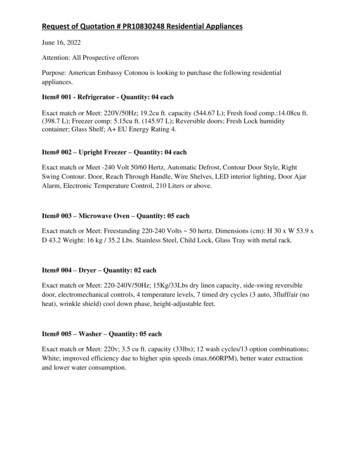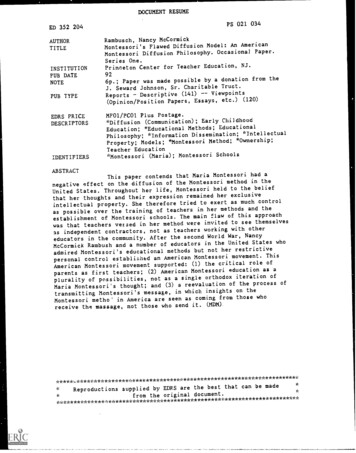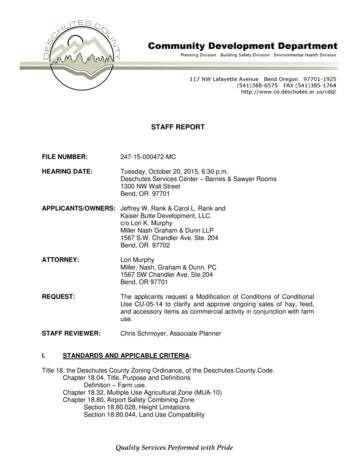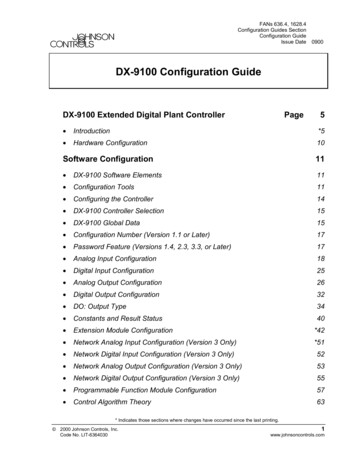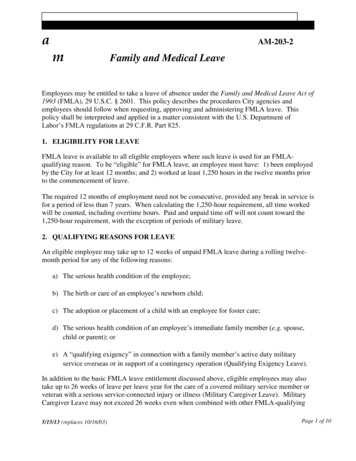
Transcription
AM-204-22aAM-203-2mFamily and Medical LeaveEmployees may be entitled to take a leave of absence under the Family and Medical Leave Act of1993 (FMLA), 29 U.S.C. § 2601. This policy describes the procedures City agencies andemployees should follow when requesting, approving and administering FMLA leave. Thispolicy shall be interpreted and applied in a matter consistent with the U.S. Department ofLabor’s FMLA regulations at 29 C.F.R. Part 825.1. ELIGIBILITY FOR LEAVEFMLA leave is available to all eligible employees where such leave is used for an FMLAqualifying reason. To be “eligible” for FMLA leave, an employee must have: 1) been employedby the City for at least 12 months; and 2) worked at least 1,250 hours in the twelve months priorto the commencement of leave.The required 12 months of employment need not be consecutive, provided any break in service isfor a period of less than 7 years. When calculating the 1,250-hour requirement, all time workedwill be counted, including overtime hours. Paid and unpaid time off will not count toward the1,250-hour requirement, with the exception of periods of military leave.2. QUALIFYING REASONS FOR LEAVEAn eligible employee may take up to 12 weeks of unpaid FMLA leave during a rolling twelvemonth period for any of the following reasons:a) The serious health condition of the employee;b) The birth or care of an employee’s newborn child;c) The adoption or placement of a child with an employee for foster care;d) The serious health condition of an employee’s immediate family member (e.g. spouse,child or parent); ore) A “qualifying exigency” in connection with a family member’s active duty militaryservice overseas or in support of a contingency operation (Qualifying Exigency Leave).In addition to the basic FMLA leave entitlement discussed above, eligible employees may alsotake up to 26 weeks of leave per leave year for the care of a covered military service member orveteran with a serious service-connected injury or illness (Military Caregiver Leave). MilitaryCaregiver Leave may not exceed 26 weeks even when combined with other FMLA-qualifying5/15/13 (replaces 10/16/03)Page 1 of 10
AM-204-22aAM-203-2mFamily and Medical Leaveleaves.When an employee and his or her spouse both work for the City of Baltimore, each will belimited to a combined total of 12 weeks of leave in a leave year for the following reasons: 1) forthe birth of the employee’s child or to care for the child after birth; 2) the placement of a son ordaughter with the employee for adoption or foster care or to care for a child after placement; and3) to care for the employee’s parent with a serious health condition. Leave taken for otherqualifying reasons will not count toward the combined limitation. Likewise, spouses who seekFMLA leave to care for a covered military service member or veteran are limited to a combined26 weeks of leave.For example, a married couple employed by the City may take up to a total 12 weeks of FMLAleave between them for the birth of a healthy child. However, the same couple may each take upto 12 weeks of FMLA leave to care for a child with a serious health condition, provided theyhave not already exhausted their FMLA leave entitlement for the leave year.3. ROLLING LEAVE YEARThe City of Baltimore uses a “rolling backward” method for calculating the 12-month FMLAleave entitlement, meaning City agencies will look back 12 months from the date the employee isexpected to start a new period of FMLA leave to determine leave eligibility and whether theemployee has already exhausted his or her leave entitlement for the 12-month period (or “leaveyear”).For example, if an employee requests five weeks of FMLA leave starting on December 5, 2013,the agency will look back 12 months from that date to see whether the employee has alreadyused the maximum amount of FMLA leave to which he or she would be entitled. If not, theemployee will be permitted to use the balance of any remaining leave.4. CONDITIONS OF LEAVEFMLA leave usually will be taken for a period of consecutive days, weeks or months.Employees may also take FMLA leave on an intermittent or reduced leave schedule basis eitherwhen medically necessary or for qualifying exigencies. When intermittent leave or a reducedschedule is requested, the City may in its discretion temporarily transfer the employee to anequivalent position (with equivalent pay and benefits) that would better accommodate recurringperiods of leave.FMLA leave will be tracked in increments of 30 minutes, unless otherwise provided in anapplicable labor agreement. Agencies may not require employees to take (and employees shall5/15/13 (replaces 10/16/03)Page 2 of 10
AM-204-22aAM-203-2mFamily and Medical Leavenot use) more leave than is needed to address the circumstances that prompted the leave request.While on FMLA leave, employees must use any accrued vacation, personal, compensatory andsick leave, as appropriate. Paid leave must be used in accordance with applicable City leavepolicies and labor agreements.The substitution of paid leave does not extend the length of an FMLA leave, and the paid timeoff will run concurrently with an employee’s FMLA entitlement. Likewise, leaves taken inconnection with a disability leave plan or workers’ compensation shall run concurrently with anyFMLA leave entitlement.The substitution of paid sick leave will be authorized only in connection with an employee’s ownserious health condition or the employee’s need for pre- or postnatal health care. An employeemay also use up to 5 days of paid sick leave for the care of a family member with a serioushealth condition or for adoption or the placement of a child in foster care.Employees of the Baltimore City Fire Department should refer to the department’s internalpolicies and procedures governing the use of paid leave for FMLA purposes. Where a conflictexists, the department’s own internal policies and procedures shall apply.5. CONTINUATION OF BENEFITSWhile an employee is on FMLA leave, the City will continue the employee’s health benefits atthe same level and under the same conditions as if the employee had continued to work. Undercurrent City policy, employees pay a portion of the health care premium. While on paid leave,the City will continue to make payroll deductions to collect the employee’s share of thepremium. While on unpaid leave, the employee must continue to make these premium paymentsthrough direct billing with the Employee Benefits Division – Premium Billing. The City willcontinue to pay the employer portion of the premiums for up to 6 bi-weekly pay periods or 12weekly pay periods (or up to 13 bi-weekly/26 weekly pay periods in the case of MilitaryCaregiver Leave). At the end of this period, the employee will be required to pay 100% of thehealth benefits premium cost.Where premium payments made through direct billing are more than 30 days late, the City mayterminate the employee’s health coverage for the duration of leave. The City will provide theemployee at least 15 days advance written notice before terminating coverage. The coveragewill be reinstated the first day following the employee’s return to work, with no waiting periodsor pre-existing condition exclusions, provided the employee contacts Employee Benefits within60 days of return.If an employee chooses not to return to work for reasons other than a continued serious healthcondition or a circumstance beyond the employee’s control, the City will require the employee to5/15/13 (replaces 10/16/03)Page 3 of 10
AM-204-22aAM-203-2mFamily and Medical Leavereimburse the City the amount paid for the employee’s health premiums during any unpaidportion of the leave. If at any time (either before or during leave) an employee gives notice ofintent not to return to work, health benefits will be discontinued.Employees on FMLA leave are entitled to other benefits to the same extent they are provided toemployees on comparable forms of leave. Employees will continue to accrue vacation, personaland sick leave, for example, as long as they remain in pay status. Employees on FMLA leavealso may continue their group life insurance coverage during the leave.6. SERIOUS HEALTH CONDITIONA serious health condition refers to a physical or mental condition that involves either anovernight stay in a medical care facility or continuing treatment by a health care provider for acondition that prevents the employee (or a covered family member) from working, attendingschool or participating in daily activities. Subject to certain conditions, the “continuingtreatment” requirement may be met by a period of incapacity of more than three consecutivecalendar days combined with: 1) at least two visits to a health care provider within 7 days ofincapacity; or 2) one visit and a regiment of continuing treatment under the supervision of ahealthcare provider.A serious health condition also refers to any period of incapacity or treatment connected withpregnancy or a chronic, long-term or permanent medical condition.7. COVERED FAMILY MEMBERSFMLA leave to care for a family member with a serious health condition is limited to a spouse,parent or child. The term “child” refers to a biological child, adopted child, foster child,stepchild, legal ward or the child of a person standing in loco parentis (in the place of a parent)who is:a) Under the age of 18; ORb) Age 18 or older and incapable of self-care due to a mental or physical disability.A covered parent includes a biological, adopted, step or foster parent or any individual whostands or stood in loco parentis when the employee was a son or daughter as described above. Aparent “in-law” is not covered.Employees must provide appropriate documentation confirming the existence of a familyrelationship or the age of a child, such as a birth or marriage certificate, court document or awritten statement of a qualifying family relationship.5/15/13 (replaces 10/16/03)Page 4 of 10
AM-204-22aAM-203-2mFamily and Medical Leave8. LEAVE FOR BIRTH, ADOPTION OR PLACEMENT FOR FOSTER CAREBoth parents may take FMLA leave for the birth or care of a newborn child. The mother alsomay take FMLA leave for incapacity due to pregnancy, for pre- or postnatal health care or for aserious health condition following birth. In the case of adoption and placement for foster care,employees may take FMLA leave before the actual placement or adoption if an absence fromwork is required for the placement or adoption to proceed.An employee may not take leave on an intermittent or reduced work schedule basis afterplacement or birth, unless such arrangements are needed in connection with a serious healthcondition or are otherwise authorized by the employing agency. An employee’s entitlement toleave for birth, adoption or placement for foster care expires 12 months following the date ofbirth, adoption or foster care placement.9. QUALIFYING EXIGENCY LEAVEThe purpose of Qualifying Exigency Leave is to allow employees with close family membersserving in the Armed Forces overseas to take time off from work to address common challengesthat arise in connection with a deployment.Agencies may grant Qualifying Exigency Leave to any eligible employee (e.g. a parent, spouseor child of a military service member) for exigencies that arise out of an active duty deploymentoverseas or in connection with a call or impending call or order to active duty service overseas.Such leave is available to members of the Regular Armed Forces who are deployed to a foreigncountry, as well as members of the National Guard and Reserves who are either deployed withthe Armed Forces to a foreign country or under a federal call or order to active duty in support ofa contingency operation.Qualifying Exigency Leave may be granted for any of the following reasons: a) to address issuesthat arise from a short-notice deployment (up to seven days); b) to attend official military events,briefings and programs; c) to provide or arrange for child care on an urgent, immediate needbasis; d) to enroll or transfer a child to a new school or day care and attend school-relatedmeetings; e) to make or update financial and legal arrangements; f) to attend counseling; g) tocare for a service member’s parent who is incapable of self-care on an urgent, immediate needbasis (or arranging for such care); h) to attend arrival ceremonies, reintegration briefings andother post-deployment activities; i) to address issues that arise from the death of the militarymember while on active duty; and j) other events that arise out of an overseas deployment orcontingency operation, as agreed upon by the agency and the employee.In addition, an eligible employee may take up to 15 calendar days of Qualifying Exigency Leaveper leave year to spend time with a military member who is on short-term, temporary Rest and5/15/13 (replaces 10/16/03)Page 5 of 10
AM-204-22aAM-203-2mFamily and Medical LeaveRecuperation leave during a covered military deployment. An employee who requests leave forthis purpose must provide a copy of the military member’s Rest and Recuperation leave orders.10. MILITARY CAREGIVER LEAVEMilitary Caregiver Leave provides eligible employees with up to 26 weeks of leave per leaveyear to care for a covered service member or veteran with a serious service-connected injury orillness. To qualify for Military Caregiver Leave, an eligible employee must be the spouse, parentor child (any age) of the covered service member or veteran or the next of kin.Covered service members include current members of the Armed Forces and members of theNational Guard or Reserves who are: a) undergoing medical treatment, recuperation or therapyfor a serious illness or injury; b) in outpatient status; or 3) on the temporary disability retired list.Leave to care for a covered veteran (a former member of the Armed Forces or the NationalGuard or Reserves) may be taken for up to 5 years following discharge from the military,provided the veteran’s release from duty was under conditions other than dishonorable. Seriousinjury or illness in the case of a veteran includes:a) The continuation of a serious injury or illness suffered while serving as a member of theArmed Forces and which has rendered the veteran unable to perform military duties;b) A physical or mental condition for which the veteran received a U.S. Department ofVeterans Affairs Service-Related Disability Rating of 50% or greater;c) A physical or mental condition that substantially impairs the veteran’s ability to secure ormaintain substantially gainful occupation; ord) An injury (including psychological injury) that serves as the basis for the veteran’senrollment in the Department of Veterans Affairs Program of Comprehensive Assistancefor Family Caregivers.11. REQUESTING FMLA LEAVEEmployees who wish to take FMLA leave must timely notify their agencies of the need forFMLA leave and the anticipated timing and duration of the leave, if known. When the need forleave is foreseeable, employees must provide at least 30 days advance notice. When 30 days’notice is not possible, or the need for leave is not foreseeable, employees must provide notice assoon as practicable under the circumstances – generally the same or the next business day.Employees should complete an FMLA Leave Request Form (AM-203-2-1) in application for5/15/13 (replaces 10/16/03)Page 6 of 10
AM-204-22aAM-203-2mFamily and Medical Leaveleave.Calling in “sick” without providing reasons for needing leave will not be considered sufficientnotice for FMLA leave under this policy, and employees are expected to respond to questionsdesigned to determine if an absence is potentially FMLA-qualifying. Employees who seek touse previously approved FMLA leave must specifically reference the FMLA-qualifying reasonwhen calling in. Leave may be delayed or denied where an employee fails to adequately explainthe reasons for the leave.Employees must follow departmental call-in procedures when requesting FMLA leave, absentunusual circumstances. Where an employee fails to comply with these procedures, and nounusual circumstances justify the failure to comply, leave may be delayed or denied and theemployee may be subject to discipline.In the case of planned medical treatment, employees must make a reasonable effort to scheduletreatment so as not to disrupt the operations of the agency. Employees must consult with theirsupervisors prior to scheduling treatment in order to work out a treatment schedule that best suitsthe needs of both the agency and the employee, subject to the approval of an employee’s healthcare provider.Employees on FMLA leave are expected to be reasonably responsive to and communicate withtheir agencies during the leave and may be required to check in periodically (e.g. at least onceeach month) regarding their status and intent to return to work.12. PROCESSING LEAVE REQUESTSWhen an employee requests FMLA leave, or when an agency acquires knowledge that anemployee’s leave may be for an FMLA-qualifying reason, the agency must notify the employeewithin 5 business days of his or her eligibility to take FMLA leave, absent extenuatingcircumstances preventing timely notice. Agencies shall provide notice using the Notice ofEligibility and Rights & Responsibilities (AM-203-2-2) form.The Notice of Eligibility and Rights and Responsibilities should be accompanied by any requiredcertification forms. Once the agency has enough information to determine whether an eligibleemployee is requesting leave for an FMLA-qualifying reason, the agency must notify theemployee whether the leave will be designated as FMLA leave. The agency will provide thisnotice within 5 business days by delivering to the employee a completed Designation Notice(AM-203-2-3).In any instance where the employer does not have sufficient information about the reason for anemployee’s use of leave, the agency should inquire further of the employee to ascertain whether5/15/13 (replaces 10/16/03)Page 7 of 10
AM-204-22aAM-203-2mFamily and Medical Leaveleave is potentially FMLA-qualifying.13. CERTIFICATION REQUIREMENTSDepending on the nature of the leave sought, employees will be required to submit appropriatecertification supporting the need for FMLA-qualifying leave. When leave is requested inconnection with a serious health condition, for example, the request must be supported bymedical certification from a health care provider. In the case of the employee’s own serioushealth condition, the employee must return a completed Certification of Health Care Providerfor Employee’s Serious Health Condition (AM-203-2-4). In the case of a family member’sserious health condition, the employee must return a completed Certification of Health CareProvider for Family Member’s Serious Health Condition (AM-203-2-5).Certification and other supporting documentation also will be required to take QualifyingExigency Leave, Certification of Qualifying Military Exigency (AM-203-2-8) and MilitaryCaregiver Leave, Certification of Health Care Provider for Military Caregiver Leave – Servicemember (AM-203-2-6) or Certification of Health Care Provider for Military Caregiver Leave –Veteran (AM-203-2-7).It is the employee’s responsibility to provide the agency with timely, complete and sufficientcertification. Whenever possible, employees should submit the completed certification at thetime leave is requested. In any event, employees must provide the certification within 15calendar days once it is requested by the agency, absent extenuating circumstances. Agenciesmay deny FMLA leave to an employee who fails to provide certification in a timely manner.When it is necessary to verify that the information contained in a medical certification wasauthorized by the health care provider, or to understand the handwriting or meaning of aresponse, an agency HR Representative or management official (other than a direct supervisor)may contact the employee’s health care provider to obtain verification or clarification. If theemployee refuses to permit such contact, the agency may deny the leave if the certification isunclear.When a certification is incomplete or insufficient, the agency may reject the certification andgive the employee at least 7 calendar days to cure any deficiencies. When rejecting acertification, the agency must provide the employee with a letter that describes what additionalinformation is needed to make the certification complete and sufficient. If the employee fails tocure deficiencies in a timely manner, the agency may delay or deny the leave request.If in the case of an employee’s own serious health condition or that of a family member anagency has reason to doubt the medical certification, it may require a second medical opinion. Ifthe opinions of the initial and second health care providers differ, the agency may require a third,final and binding certification from a health care provider jointly approved by the agency and theemployee. The agency must conditionally approve the employee’s leave request pending the5/15/13 (replaces 10/16/03)Page 8 of 10
AM-204-22aAM-203-2mFamily and Medical Leaveoutcome and bear the expense of acquiring the second and/or third medical opinion (includingreasonable out-of-pocket travel expenses connected with the appointment). Agencies may notrequire a second or third opinion when Military Caregiver Leave has been requested.14. RECERTIFICATIONAgencies shall require employees to recertify the need for FMLA leave for a serious healthcondition of the employee or a family member: 1) whenever the expected minimum duration ofleave expires; or 2) at least every six months in connection with an absence. Agencies may alsorequest recertification when:a) The employee requests an extension of the leave;b) Circumstances described in the employee’s current certification have changedsignificantly (such as the duration or frequency of absences or the nature or severity ofthe illness); orc) Information is received that casts doubt upon the employee’s stated reason for theabsence or the continuing validity of the certification.Agencies may not request recertification in the case of Military Caregiver Leave.Agencies should use the appropriate recertification form: Recertification of Employee’s SeriousHealth Condition (AM-203-2-9) or Recertification of Family Member’s Serious HealthCondition (AM-203-2-10). Agencies shall give employees at least 15 calendar days to return therecertification.Where recertification is prompted by changed circumstances or doubts about the continuingvalidity of the existing certification, the agency shall give the health care provider theemployee’s FMLA attendance record to help him or her determine whether leave usage isconsistent with the serious health condition in question.15. RETURN TO WORKAt the end of FMLA leave, the employee will be restored to the same position held prior to leaveor a position with equivalent pay, status, benefits and other employment terms, subject to certainexceptions. An agency may in its discretion elect not to return certain “key” employees, forexample, if doing so would cause grievous and economic harm to the agency. Similarly, anagency may deny reemployment if there has been an intervening layoff that would have includedthe employee’s position.5/15/13 (replaces 10/16/03)Page 9 of 10
AM-204-22aAM-203-2mFamily and Medical LeaveAn employee returning to work following his or her own serious health condition must provide aFitness For Duty Certification of Health Care Provider (AM-203-2-11) form completed by thehealth care provider. The certification must confirm the employee’s ability to resume work andto perform all essential job functions. Agencies may delay or deny job restoration until theemployee returns the completed certification.Agencies shall notify employees of this requirement at the start of leave by so indicating on theemployee’s Designation Notice. Where appropriate, agencies should also include a list of theessential functions of the employee’s position for use by the health care provider in determiningthe employee’s readiness to return to work.16. DISCRIMINATION PROHIBITEDThis policy prohibits discrimination against an individual for having exercised the right to takeFMLA leave and prohibits unlawful interference with an individual’s FMLA rights. In addition,this policy prohibits illegal retaliation against someone who has made an FMLA-relatedcomplaint or who has participated in the investigation of a complaint.Concerns about discrimination, interference or retaliation under this policy should beimmediately reported to the employing agency’s Equal Opportunity Compliance (EOC) Officeror an HR Representative.5/15/13 (replaces 10/16/03)Page 10 of 10
The substitution of paid leave does not extend the length of an FMLA leave, and the paid time off will run concurrently with an employee's FMLA entitlement. Likewise, leaves taken in connection with a disability leave plan or workers' compensation shall run concurrently with any FMLA leave entitlement.
